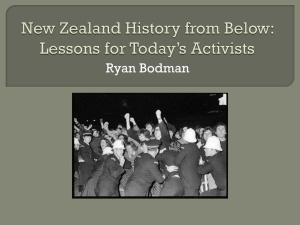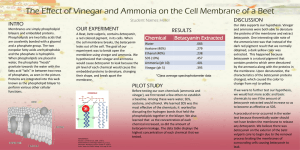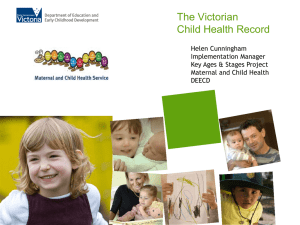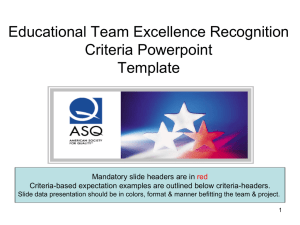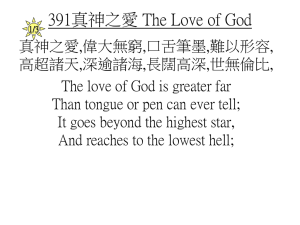Chr 16
advertisement
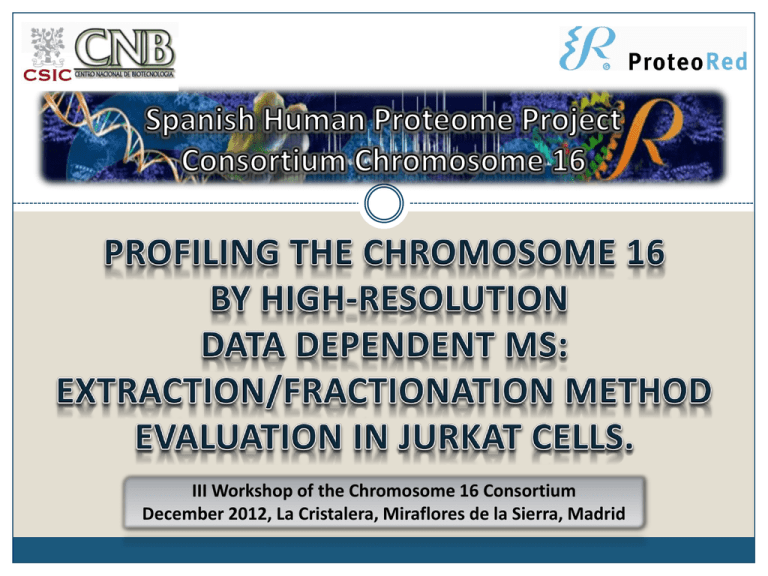
III Workshop of the Chromosome 16 Consortium December 2012, La Cristalera, Miraflores de la Sierra, Madrid METHODOLOGY TOTAL PROTEOME COVERAGE COMPARING FRACTIONATION METHODS COMPARING CELL-LYSING CONDITIONS CHROMOSOME 16 COVERAGE MAPPING POST-TRANSLATIONAL MODIFICATIONS OF THE Chr 16 ISSUE OF ISOFORMS: Test of Protein Grouping COMPARING MASS SPECTROMETERS Jurkat T cells RIPA CHAPS/UREA 4% SDS 1D-SDS PAGE Methanol/Chloroform precipitation In-solution digestion Off-line HPLC-RP Basic pH 30 fractions / pooled into 10 15 bands HPLC-RP Acid pH 5600-Ttof (CID) Cut bands Automatic In-gel digestion Digestor (Bruker) TOTAL PROTEINS / PEPTIDES IDENTIFIED FDR 1% Protein level R.1 R.2 R.1 R.2 R.1 R.2 R.1 R.2 R.1 R.2 R.1 R.2 CHAPS RIPA 4% SDS 1D SDS-PAGE CHAPS RIPA 4% SDS HPLC-RP 92278 peptides 12159 proteins PROTEIN OVERLAPPING BETWEEN REPLICATES CHAPS HPLC-RP CHAPS 1D SDS-PAGE 1415 3755 Replicate 1 Replicate 2 1456 1001 6721 2098 Replicate 1 Replicate 2 Good overlapping between replicate experiments for the Gel or off-line basicRP prefractionation methods. PROTEIN OVERLAPPING BETWEEN FRACTIONATION METHODS 474 4737 1D SDS-PAGE HPLC-RP 4082 4% SDS – Replicate 2 RIPA – Replicate 2 CHAPS – Replicate 2 905 5350 1D SDS-PAGE HPLC-RP 2449 871 4794 2431 1D SDS-PAGE HPLC-RP For all the cell-lysing conditions tested, the in-solution digestion-basicRP-LC/MS workflow was by far the most compatible (between 20-30% more proteins identified). NUMBER OF EXCLUSIVE PROTEINS PER EXPERIMENT R.1 R.2 R.1 R.2 R.1 R.2 R.1 R.2 R.1 R.2 R.1 R.2 CHAPS RIPA 4% SDS 1D SDS-PAGE CHAPS RIPA HPLC-RP 4% SDS More exclusive proteins identified by HPLC-RP TOTAL PROTEINS / PEPTIDES CHAPS/ UREA 2 Replicates RIPA 4% SDS 1D SDS-PAGE HPLC-RP Different cell-lysis conditions gave similar proteome coverage in the Gel-LC-MS workflow. CHAPS lysis enabled greater protein identification in the basic-RP-LC/MS workflow. The excess of detergents that would alter protein precipitation and digestion. PROTEIN OVERLAPPING BETWEEN EXTRACTION METHODS 2 Replicates 1D SDS-PAGE HPLC-RP 492 1338 614 5163 586 6386 637 546 More exclusive proteins identified by CHAPS lysis combined with in-solution digestion/off-line HPLC separation. CHROMOSOME 16 PROTEINS/PEPTIDES R.1 R.2 R.1 R.2 R.1 R.2 R.1 R.2 R.1 R.2 R.1 R.2 CHAPS RIPA 4% SDS 1D SDS-PAGE CHAPS RIPA 4% SDS HPLC-RP 4000 péptidos 447 proteínas 351 genes Chr 16 PROTEINS: SUBCELLULAR LOCALIZATION CHAPS lysis was better in recovering most sub-cellular compartments even for membrane proteins. However, our ability to identify membrane proteins is low and we should considerate using plasma membrane enrichment methods (subcellular fractionation, cell-surface biotinylation…) Jurkat CHAPS HPLC-RP Replicate 2 PHOSPHORYLATION ACETYLATION Chr 16: 56 peptides N-term acetylated TOTAL: 1317 P-Peptides / 865 P-Proteins Chr 16: 66 P-Peptides / 42 P-Proteins Chr 16: % of acetylated peptides % of acetylated peptides 4,50 4,01 4,00 3,33 3,50 2,50 2,35 2,26 3,01 3,00 2,85 3,00 2,00 2,23 2,38 2,53 2,58 2,00 1,50 1,00 0,50 0,00 R.1 R.2 R.1 R.2 R.1 R.2 R.1 R.2 R.1 R.2 1 2 3 4 5 6 7 8 9 10 R.1 11 R.2 12 CHAPS RIPA 4% SDS 1D SDS-PAGE CHAPS RIPA 4% SDS HPLC-RP Average of 3% of peptides found acetylated TOTAL/Chr 16 PROTEINS AND PEPTIDES Replicate 2 Jurkat TOTAL - PG CHAPS - PG RIPA - 4% SDS 1D SDS-PAGE FDR 1% Protein level PG Chr 16 - PG CHAPS - PG RIPA HPLC-RP - PG 4% SDS - PG CHAPS - PG RIPA - PG 4% SDS 1D SDS-PAGE - PG CHAPS - PG RIPA - PG 4% SDS HPLC-RP IMPORTANTE: Exportar datos siempre de la misma forma 10 Fractions CHAPS/UREA TToF 5600 CNB Replicate 1 Q-Exactive Jurkat CHAPS HPLC-RP UPV 10 fractions Replicate 2 TToF 5600 CNB TOTAL/Chr 16 PROTEINS AND PEPTIDES Jurkat CHAPS HPLC-RP TOTAL Rep 1 CNB Rep 1 UPV Chr 16 Rep 2 CNB Rep 1 CNB Rep 1 UPV Rep 2 CNB Both mass spectrometers are comparable FDR 1% Protein level PROTEIN OVERLAPPING Jurkat CHAPS HPLC-RP TOTAL Chr 16 11 1218 1315 345 9723 43 46 532 Replicate 1 - CNB Replicate 1 - UPV Replicate 2 - CNB FDR 1% Protein level Replicate 1 - CNB Replicate 1 - UPV Replicate 2 - CNB Reproducibility We have tested various workflows to increase our coverage of the Chr16. We have used strong detergents to better solubilize and resolve membrane proteins and show that due to the low compatibility with in-solution digestion, proteins were not so efficiently recovered. Our observation was that CHAPS cell-lysis coupled to basic-RP-LC/MS provided the best results. We are combining various approaches to gain more insight and coverage of proteins of low solubility and their post-translational modification profiles: • Cell-surface biotinylation • Phosphopeptide enrichment We are generating an increasing number of mass spectras and we will build an MS/MS library that will hopefully be used for MRM validations. Rosana Navajas Severine Gharbi Miguel Marcilla Alberto Paradela Carmen González Gonzalo Martínez Alberto Medina Salvador Martínez Antonio Ramos Miguel Ángel López Mª Carmen Mena Fernando Roncal Manuel Lombardía Adán Alpízar Silvia Juárez Sergio Ciordia Marisol Fernández Virginia Pavón Lola Segura

